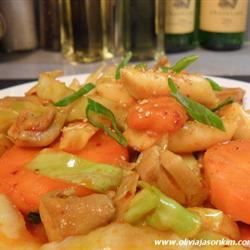Another hot, stir-fried chicken dish that many Koreans seem to adore is dak galbi. The key difference between this dish and other spicy foods is the addition of cabbage, which gives it a distinctive and pleasing aroma, and typically perilla leaves. Many dak galbi restaurants and quasi-bars place a single, sizable frying pan in the middle of the table so that everyone can consume their food together (Koreans actually enjoy doing so). Serve alongside rice.
| Prep Time: | 20 mins |
| Cook Time: | 30 mins |
| Total Time: | 50 mins |
| Servings: | 8 |
| Yield: | 2 pounds of chicken |
Ingredients
- 1 tablespoon vegetable oil
- 2 pounds skinless, boneless chicken breast halves, cut into bite-size pieces, or more as needed
- ¼ cup gochujang (Korean hot pepper paste)
- 2 tablespoons soy sauce
- 2 tablespoons gochugaru (Korean red pepper flakes)
- 1 tablespoon mirin (Japanese sweet wine)
- 1 tablespoon brown sugar
- 1 tablespoon sesame oil
- 4 cloves garlic, minced
- ¼ teaspoon ground black pepper
- ¼ teaspoon ground ginger
- 2 cups Korean-style glutinous rice cakes (tteok)
- ¼ large head cabbage, sliced into strips
- 1 sweet potato, sliced into rounds
- ½ onion, chopped
- 3 scallions, sliced into 1-inch pieces, divided
- 4 leaves perilla leaves, sliced, or to taste
- ½ cup water
- 1 tablespoon sesame seeds
Instructions
- Heat oil in a large nonstick saucepan. Add chicken pieces; cook and stir until nearly opaque, 4 to 7 minutes.
- Combine gochujang, soy sauce, gochugaru, mirin, brown sugar, sesame oil, garlic, black pepper, and ginger in a bowl. Add to the saucepan with the chicken. Cook and stir until chicken pieces are browned and well coated, 3 to 5 minutes.
- Stir rice cakes, cabbage, sweet potato, and onion into the skillet with the chicken mixture. Cook until sweet potato changes color, about 10 minutes. Add 2 to 2 1/2 scallions and perilla leaves. Cook until wilted, about 3 minutes. Add more water if sauce seems to be drying up. Garnish with remaining scallions and sesame seeds.
- Chicken thighs can be substituted for the breasts, if desired.
- Use any cooking wine you prefer.
- In Korean restaurants (and now at home, too) it’s common to add some more rice, gim (dried seaweed), and sesame oil to the remaining sauce in the pan. Mix it together well and this will provide a great, last bite to your meal.
Nutrition Facts
| Calories | 386 kcal |
| Carbohydrate | 53 g |
| Cholesterol | 59 mg |
| Dietary Fiber | 3 g |
| Protein | 26 g |
| Saturated Fat | 1 g |
| Sodium | 384 mg |
| Sugars | 7 g |
| Fat | 7 g |
| Unsaturated Fat | 0 g |
